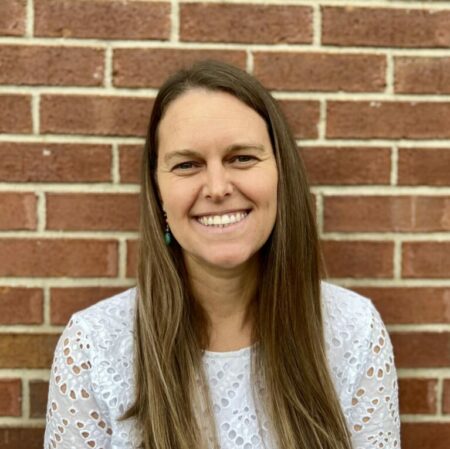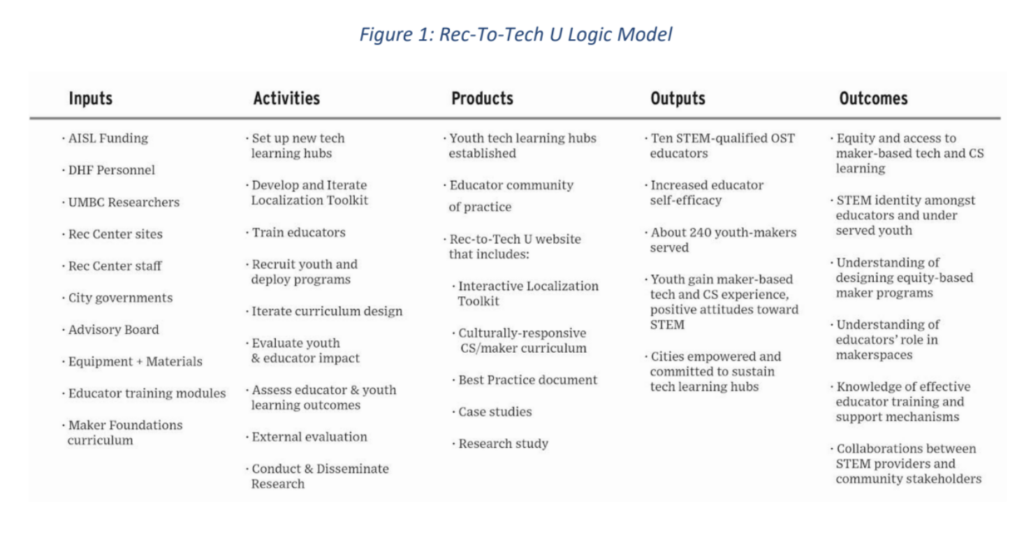We recently received the Year 3 evaluation report for our collaborative National Science Foundation (NSF) grant Rec-to-Tech: Understanding the Role of Rec Center Educators in Creating Maker-based Technology and Computer Science. We’re grateful for the careful evaluation and are excited to share some of the takeaways about the current outcomes and ideas for future consideration. Many thanks to our wonderful collaborators at UMBC for their partnership on all of this as well!
“The project has also unveiled a few unintended outcomes such as discovering new methods for measuring and assessing youth experiences and STEM learning and the impacts of infrastructure in Rec Centers on delivering equity-focused STEM learning opportunities.”
This project is supported by funding from the NSF (NSF – AISL – Innovations in Development Project Learning Hubs for Urban Youth). We thank MN Associates, Inc. for their support reporting on these activities.

Liz McCreary
Impact Director, Digital Harbor Foundation
December 18, 2023
About the Project
Rec-To-Tech U builds upon an earlier collaboration between Digital Harbor Foundation and
UMBC installed makerspaces at Rec Centers in Baltimore and built professional development and teaching resources for informal educators. The results were positive and yielded strategies for building informal curricula and found evidence that Rec Centers could be valuable partners as anchor institutions for increasing access to STEM learning. The purpose of Rec-To-Tech U is to further examine the role of the educator in delivering equity-focused STEM learning in informal settings and developing equity-based resources for educators through co-design and localization.
The outcomes of this project intend to help broaden access to and increase participation in equity-focused making and computer science learning.
The project structure is iterative in that DHF leads efforts to develop partnerships with Rec Centers and oversee the design of resources and stakeholder involvement, while the UMBC research team works closely with Rec Center sites and educators to develop curricula, facilitate professional development, participate in providing instruction, and collect and analyze data/feedback from educators and youth. The research findings are communicated to DHF staff who then work to design resources and drive program adaptations for each successive phase of the project. The resources and strategies are then presented to stakeholders including rec center leadership and educators as well as experts in STEM education from across the country participating as members of the Rec-To-Tech U Advisory Board and/or Localization Committee. This structure is akin to a trade cycle in that it ebbs and flows, expands, and contracts, based on the needs and circumstances of all stakeholders at a given moment in time.
Objectives, Deliverables, and Outcomes
There are three objectives of the Rec-To-Tech U project:
-
- Understand the role of the educator in creating maker-based technology and computer science learning hubs for urban youth as a catalyst for organizational transformation, a builder of community values and collective impact, and a role model for youth in developing positive attitudes toward STEM and self-efficacy.
- Create, evaluate, and disseminate a Localization Toolkit that will provide OST educators with resources to apply equity-based design principles to collaborate with youth and community stakeholders to develop STEM-focused youth programs.
- Broaden participation of underserved youth in maker-based technology and computer science learning. The Localization Toolkit will support OST educators to approach maker-based and technology experiences through an equity-based approach that draws on the interests and needs of local youth and their communities.
There are two main deliverables for the Rec-to-Tech U project:
-
- A Localization Toolkit for educators to use an equity-based approach to collaboratively design maker-based technology and computer science experiences that will improve youth’s self-efficacy, creativity, and attitudes toward STEM. The toolkit will enhance the field’s knowledge, build educator capacity, and increase collaborations among STEM providers and other community stakeholders. The toolkit will include resources to implement an equity- based approach, a technology curriculum, an iterative design process to collaborate with youth on content/curriculum development, case studies, and best practices. The Localization Toolkit will serve as an effective model beyond the grant period, ensuring OST providers have the resources to implement more equitable making-based and computer science programs in their communities.
- A Design-Based Research Study focused on transforming Rec Centers into STEM learning hubs and understanding the role of educators in effectively designing and delivering maker-based technology and computer science curriculum to urban youth. The study will expand the field’s knowledge of educators’ impact on OST STEM experiences and will be of interest to practitioners and researchers who are charged with broadening participation and are seeking to use an equity-based approach to maximize strategic impact.
The Rec-to-Tech U Logic Model articulates the relationship between planning, implementation, and outcomes as follows:

Project Sites
Year 3 welcomed a new site (Middle Branch) and (re)engaged another site (Hilton) in Baltimore. Programs continued at both Ammons and Paulson in Pittsburgh and Herring Run in Baltimore.
The following is the list of recreation center partners in Year 3:
-
- City of Pittsburgh Department of Parks & Recreation (CitiParks)
- Paulson Recreation Center
- Ammon Recreation Center
- Herring Run
- Hilton Rec Center
- Middle Branch Fitness & Wellness Center
- City of Pittsburgh Department of Parks & Recreation (CitiParks)
Conclusions
The third year of the Rec-to-Tech U project has been successful due not only to making strides in the delivery of two iterations of professional development and programs but also to applying the equity-based design theoretical framework to real situations through co-design and localization efforts. Results include exploring shifts in power dynamics and identifying program delivery models capable of mitigating bureaucracy and increasing access to STEM programming in Rec Centers. The project has also unveiled a few unintended outcomes such as discovering new methods for measuring and assessing youth experiences and STEM learning and the impacts of infrastructure in Rec Centers on delivering equity-focused STEM learning opportunities. Although COVID slowed initial progress, Rec-to-Tech U shows notable promise moving into the no-cost extension. This final phase of the project will enable the project team to finalize and test the viability of the Localization Toolkit while also sharing these new tools and resources with anchor institutions in other communities.
Recommendations to Consider
-
- Increase collaboration with youth to further develop curricula and resources that respond to their needs and interests (e.g., co-design sessions with youth participants).
- Continue exploring alternative program delivery models for Rec Centers that offer additional flexibility and options for localization (e.g., summer programs, weekend workshops, city-wide competitions, social club formats, etc.).
- Explore building teen-specific programs with integrated leadership and incentivized activities (e.g., youth work models).
- Review the Localization Toolkit with the Advisory Board and Localization Committee asking for direct feedback and discussing dissemination and replication.
- Test the Localization Toolkit with both existing Rec Center partners and external, unattached Rec Centers in communities other than Pittsburgh and Baltimore.
